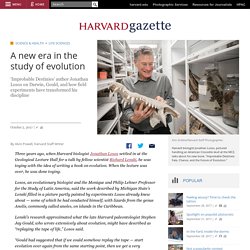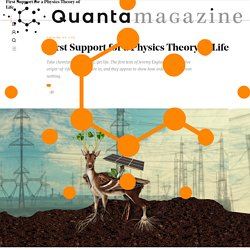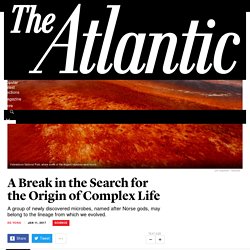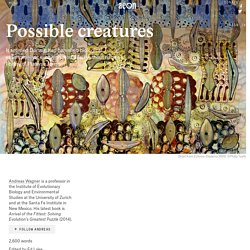

The Information Theory of Life. There are few bigger — or harder — questions to tackle in science than the question of how life arose. We weren’t around when it happened, of course, and apart from the fact that life exists, there’s no evidence to suggest that life can come from anything besides prior life. Which presents a quandary. Christoph Adami does not know how life got started, but he knows a lot of other things. His main expertise is in information theory, a branch of applied mathematics developed in the 1940s for understanding information transmissions over a wire. Since then, the field has found wide application, and few researchers have done more in that regard than Adami, who is a professor of physics and astronomy and also microbiology and molecular genetics at Michigan State University. Biologist’s new book details a new era in the study of evolution. Three years ago, when Harvard biologist Jonathan Losos settled in at the Geological Lecture Hall for a talk by fellow scientist Richard Lenski, he was toying with the idea of writing a book on evolution.

When the lecture was over, he was done toying. Losos, an evolutionary biologist and the Monique and Philip Lehner Professor for the Study of Latin America, said the work described by Michigan State’s Lenski filled in a picture partly painted by experiments Losos already knew about — some of which he had conducted himself, with lizards from the genus Anolis, commonly called anoles, on islands in the Caribbean. Lenski’s research approximated what the late Harvard paleontologist Stephen Jay Gould, who wrote extensively about evolution, might have described as “replaying the tape of life,” Losos said.
Leaving Facebook. What the ctenophore says about the evolution of intelligence. Leonid Moroz has spent two decades trying to wrap his head around a mind-boggling idea: even as scientists start to look for alien life in other planets, there might already be aliens, with surprisingly different biology and brains, right here on Earth.

Those aliens have hidden in plain sight for millennia. They have plenty to teach us about the nature of evolution, and what to expect when we finally discover life on other worlds. First Support for a Physics Theory of Life. Often, the system settles into an equilibrium state, where it has a balanced concentration of chemicals and reactions that just as often go one way as the reverse.

This tendency to equilibrate, like a cup of coffee cooling to room temperature, is the most familiar outcome of the second law of thermodynamics, which says that energy constantly spreads and the entropy of the universe always increases. (The second law is true because there are more ways for energy to be spread out among particles than to be concentrated, so as particles move around and interact, the odds favor their energy becoming increasingly shared.) But for some initial settings, the chemical reaction network in the simulation goes in a wildly different direction: In these cases, it evolves to fixed points far from equilibrium, where it vigorously cycles through reactions by harvesting the maximum energy possible from the environment. Form and Function Information Processors. No, Evolution Is Not Always Dog-Eat-Dog. Violence has been the sire of all the world’s values,” wrote poet Robinson Jeffers in 1940.

“What but the wolf’s tooth whittled so fine the fleet limbs of the antelope? What but fear winged the birds, and hunger jeweled with such eyes the great goshawk’s head?” We’ve taken these metaphors for evolution to heart, reading them to mean that life is a race to kill or be killed. Evolution Runs Faster on Short Timescales. In the 1950s, the Finnish biologist Björn Kurtén noticed something unusual in the fossilized horses he was studying.

When he compared the shapes of the bones of species separated by only a few generations, he could detect lots of small but significant changes. Horse species separated by millions of years, however, showed far fewer differences in their morphology. Subsequent studies over the next half century found similar effects — organisms appeared to evolve more quickly when biologists tracked them over shorter timescales. Then, in the mid-2000s, Simon Ho, an evolutionary biologist at the University of Sydney, encountered a similar phenomenon in the genomes he was analyzing.
When he calculated how quickly DNA mutations accumulated in birds and primates over just a few thousand years, Ho found the genomes chock-full of small mutations. Baffled by his results, Ho set to work trying to figure out what was going on. Dividing Droplets Could Explain Origin of Life. A Break in the Search for the Origin of Complex Life - The Atlantic.
In Norse mythology, humans and our world were created by a pantheon of gods who lived in the realm of Asgard.

As it turns out, these stories have a grain of truth to them. Thanks to a team of scientists led by Thijs Ettema, Asgard is now also the name of a large clan of microbes. Its members, which are named after Norse gods like Odin, Thor, Loki, and Heimdall, are found all over the world. Many of them are rare and no one has actually seen them under a microscope. But thanks to their DNA, we know they exist. If Ettema is right, then around two billion years ago, an Asgardian microbe (or an incredibly close relative) took part in a unique event that gave rise to the eukaryotes. How Old Is the Modern Human Mind? When I started learning about the Ice Age, the oldest known cave art dated to about 35,000 years ago—now it’s closer to 41,000 years.

And while they seemed like a fairly intelligent species, Neanderthals weren’t thought to have been capable of creating art (the first confirmed Neanderthal cave art—an engraved crosshatch—was announced in 2014). Most researchers didn’t think our ancestors interbred with Neanderthals (but a number of them actually did around 60,000 years ago), and we definitely didn’t know that there was a third separate humanlike species called the Denisovans living in Ice Age Europe—and that some of us carry their genes, too. Without a library of Platonic forms, evolution couldn’t work.
When it slithers through the grass, the legless glass lizard is indistinguishable from a snake.

But harass it and it will perform a very un-snakelike feat. It will leave its tail behind – still wriggling – and slide away. Under Pressure, Does Evolution Evolve? In 1996, Susan Rosenberg, then a young professor at the University of Alberta, undertook a risky and laborious experiment.

Her team painstakingly screened hundreds of thousands of bacterial colonies grown under different conditions, filling the halls outside her lab with tens of thousands of plates of bacteria. “It stank,” Rosenberg recalled with a laugh. “My colleagues hated me.” Meet Luca, the Ancestor of All Living Things. Genes are adapted to an organism’s environment.

So Dr. Martin hoped that by pinpointing the genes likely to have been present in Luca, he would also get a glimpse of where and how Luca lived. “I was flabbergasted at the result, I couldn’t believe it,” he said. The 355 genes pointed quite precisely to an organism that lived in the conditions found in deep sea vents, the gassy, metal-laden, intensely hot plumes caused by seawater interacting with magma erupting through the ocean floor. Deep sea vents are surrounded by exotic life-forms and, with their extreme chemistry, have long seemed places where life might have originated. The finding has “significantly advanced our understanding of what Luca did for a living,” James O. Dr. How Burgers and Fries Are Killing Your Microbial Balance. The Surprising Origins of Life’s Complexity. Charles Darwin was not yet 30 when he got the basic idea for the theory of evolution. But it wasn’t until he turned 50 that he presented his argument to the world. He spent those two decades methodically compiling evidence for his theory and coming up with responses to every skeptical counterargument he could think of.
Do Organisms Become More Evolvable in Times of Stress? Updated on November 18, 2015 Imagine that you wake up in a pit, surrounded by people who are all wounded and bleeding. Something had clearly gone horribly wrong. Maybe you panic. Maybe you tend to the wounded. Maybe you team up to plan an escape. When Joachim Kurtz from the University of Münster placed healthy beetles among wounded peers, he found that they can unveil mutations that are present in their genomes but whose effects are usually masked.
Under Pressure, Does Evolution Evolve? The TimeTree of Life Book. Gordon's Introduction to The Earthlife Web. Evogeneao - - Tree of Life. Return to "Download Files" Page You are welcome to download the following graphic image of the Tree of Life for non-commercial, educational purposes: Tree of Life (~3,000 species, based on rRNA sequences) (pdf, 368 KB) (see Science, 2003, 300:1692-1697) This file can be printed as a wall poster. Printing at least 54" wide is recommended. Trees of Life: A Visual History of Evolution. By Maria Popova.
Grand tree of life study shows a clock-like trend in new species emergence and diversity. Unintelligent Design. Evolution and the Unintelligent Design of Life: Inherited Traits, Genetic Dysfunction and Artificial Life. Evolution is directionless and blind. Features that evolve at one point can become a hindrance later on. Mutations and inefficiencies leads to dysfunctions and disease.
Yeast Study Suggests Genetics Are Random but Evolution Is Not. In his fourth-floor lab at Harvard University, Michael Desai has created hundreds of identical worlds in order to watch evolution at work. Each of his meticulously controlled environments is home to a separate strain of baker’s yeast. Every 12 hours, Desai’s robot assistants pluck out the fastest-growing yeast in each world — selecting the fittest to live on — and discard the rest.
A New Thermodynamics Theory of the Origin of Life. Evolution: Change: Deep Time. A Brief History of Life. The Evolution of Life on Earth. The father of all men is 340,000 years old - life - 06 March 2013. Albert Perry carried a secret in his DNA: a Y chromosome so distinctive that it reveals new information about the origin of our species. It shows that the last common male ancestor down the paternal line of our species is over twice as old as we thought. Human origins: Are we hybrids? How Many People Have Ever Lived on Earth? "How Many People Have Ever Lived on Earth? " is one of PRB's most popular articles. First published in 1995 and updated in 2002, this latest 2011 article includes data through mid-2011 and a short video explaining the estimate.
(October 2011) The question of how many people have ever lived on Earth is a perennial one among information calls to PRB. The Human Story. Survey of Earliest Human Settlements Undermines Claim That War Has Deep Evolutionary Roots. My last two posts discuss two new studies that contradict the Deep Roots Theory of War, which holds that war is ancient and innate. Early Primate Evolution: Time Scale of the Earth. Chris Stringer on the Origins and Rise of Modern Humans. Baffling 400,000-Year-Old Clue to Human Origins. Skull of Homo erectus throws story of human evolution into disarray.
Tiny, insect-eating animal becomes earliest known primate. WATCH: The Surprising Reason We Find Babies Cute. Ecosystems still feel the pain of ancient extinctions - life - 11 August 2013. The Botany of Desire - Full Length High Definition. Bird Study Questions a Driving Force in Evolution. Who’s in Charge Inside Your Head? Sci-Tech / Science : Scientists decode how life emerged from Earth’s abiotics. Extraterresterial Life Exists, Scientist Chandra Wickramasinghe Claims. What Are The Odds Of Finding Extraterrestrial Intelligent Life? 'Radiation-eating' Fungi Finding Could Trigger Recalculation Of Earth's Energy Balance And Help Feed Astronauts.
Researchers use Moore's Law to calculate that life began before Earth existed. Astrobiologists discover fossils in meteorite fragments, confirming extraterrestrial life. The truth IS out there: British scientists claim to have found proof of alien life - Science - News. The Single Theory That Could Explain Emergence, Organisation And The Origin of Life. Chiral Key Found to Origin of Life.
Earth's first life may have sprung up in ice - life - 01 November 2013. In Search of Life’s Smoking Gun - Issue 17: Big Bangs. Family trees of ancient bacteria reveal evolutionary moves. Bacteria make major evolutionary shift in the lab - life - 09 June 2008. A New Approach to Building the Tree of Life.